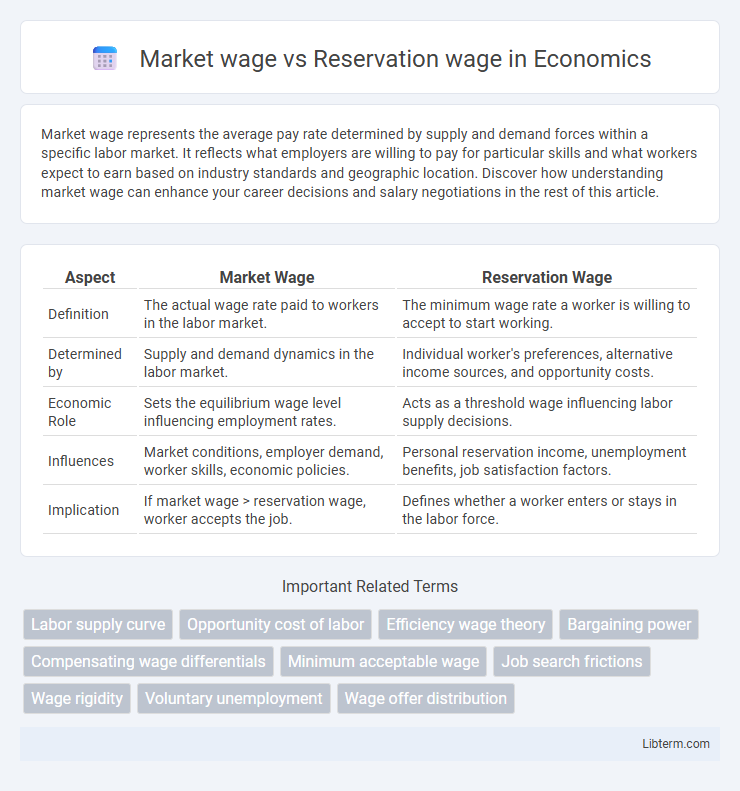Market wage represents the average pay rate determined by supply and demand forces within a specific labor market. It reflects what employers are willing to pay for particular skills and what workers expect to earn based on industry standards and geographic location. Discover how understanding market wage can enhance your career decisions and salary negotiations in the rest of this article.
Table of Comparison
| Aspect | Market Wage | Reservation Wage |
|---|---|---|
| Definition | The actual wage rate paid to workers in the labor market. | The minimum wage rate a worker is willing to accept to start working. |
| Determined by | Supply and demand dynamics in the labor market. | Individual worker's preferences, alternative income sources, and opportunity costs. |
| Economic Role | Sets the equilibrium wage level influencing employment rates. | Acts as a threshold wage influencing labor supply decisions. |
| Influences | Market conditions, employer demand, worker skills, economic policies. | Personal reservation income, unemployment benefits, job satisfaction factors. |
| Implication | If market wage > reservation wage, worker accepts the job. | Defines whether a worker enters or stays in the labor force. |
Understanding Market Wage: Definition and Factors
Market wage represents the prevailing compensation rate determined by supply and demand in the labor market, influenced by factors such as industry standards, geographic location, and worker productivity. It reflects the average remuneration employers are willing to pay for specific skills and experience levels. Understanding market wage involves analyzing economic conditions, employer competition, and labor availability, which collectively dictate wage levels across sectors.
What is Reservation Wage? An Overview
Reservation wage is the minimum wage rate at which a worker is willing to accept a particular job, reflecting their threshold for employment. It plays a crucial role in labor market decisions by influencing job search behavior and unemployment duration. Understanding reservation wage helps employers set competitive wages and aids policymakers in assessing labor market dynamics.
Key Differences Between Market Wage and Reservation Wage
Market wage represents the actual prevailing wage rate determined by supply and demand in the labor market, reflecting what employers are willing to pay for labor. Reservation wage is the minimum acceptable wage a worker is willing to accept to supply labor, influenced by factors like skills, alternative income sources, and personal preferences. The key difference lies in market wage being an external equilibrium price, while reservation wage is an individual threshold below which a worker refuses employment.
Economic Theories Behind Wage Determination
Market wage represents the actual compensation workers receive based on supply and demand dynamics in labor markets, while reservation wage denotes the minimum payment a worker is willing to accept to enter employment, reflecting individual preferences and opportunity costs. Economic theories such as the neoclassical labor market model explain wage determination through equilibrium where labor supply meets demand, contrasted by behavioral and human capital theories emphasizing reservation wage influenced by worker skills, alternatives, and bargaining power. Understanding these wages aids in analyzing labor market efficiency, unemployment phenomena, and policy impacts on wage floors and labor participation rates.
Factors Influencing Market Wage Trends
Market wage trends are influenced by factors such as labor supply and demand, productivity levels, and industry growth rates. Economic conditions, technological advancements, and government policies also play critical roles in shaping wage rates. Changes in education and skill requirements further impact the equilibrium between market wage and reservation wage dynamics.
Personal and Societal Determinants of Reservation Wage
Reservation wage is influenced by personal factors such as individual skills, educational attainment, job experience, and financial obligations, which determine the minimum acceptable salary a person is willing to accept. Societal determinants include prevailing unemployment benefits, social norms regarding work and income, labor market conditions, and the availability of social safety nets that shape wage expectations. Understanding these personal and societal influences is essential for analyzing labor market behavior and wage setting dynamics.
The Role of Education and Skills in Wage Expectations
Education and skills significantly influence the gap between market wage and reservation wage, with higher educational attainment and advanced skills raising reservation wage thresholds due to increased earning expectations. Individuals possessing specialized skills or degrees often set reservation wages closer to or above prevailing market wages, reflecting their confidence in obtaining better-paying jobs. Consequently, investments in education enhance bargaining power and wage expectations, shaping labor market dynamics and employment decisions.
Market Wage vs Reservation Wage: Impact on Employment Decisions
Market wage represents the actual compensation offered by employers based on labor demand and supply, directly influencing an individual's willingness to accept a job. Reservation wage is the minimum rate at which a worker is willing to accept employment, shaped by living costs, alternative income sources, and personal preferences. The gap between market wage and reservation wage critically affects employment decisions, with higher market wages increasing labor participation while wages below reservation levels may lead to unemployment or discouragement among workers.
Employer Strategies: Navigating Wage Discrepancies
Employers strategically manage wage discrepancies between market wage and reservation wage by conducting thorough labor market analyses to set competitive salaries that attract skilled candidates while minimizing labor costs. Implementing flexible compensation packages, including bonuses and non-monetary benefits, helps bridge gaps when reservation wages exceed prevailing market rates. Such tactics optimize talent acquisition and retention, ensuring organizational performance aligns with financial constraints.
Policy Implications and Future Wage Dynamics
Market wages, reflecting the equilibrium between labor supply and demand, often diverge from reservation wages, which represent the minimum compensation workers accept. Policies aimed at raising reservation wages, such as increasing minimum wages or expanding social safety nets, can shift labor supply curves and influence overall wage dynamics. Future wage trends will depend on the interaction between these reservation wage adjustments and market conditions, necessitating careful calibration of labor market regulations to balance employment levels and income security.
Market wage Infographic

 libterm.com
libterm.com